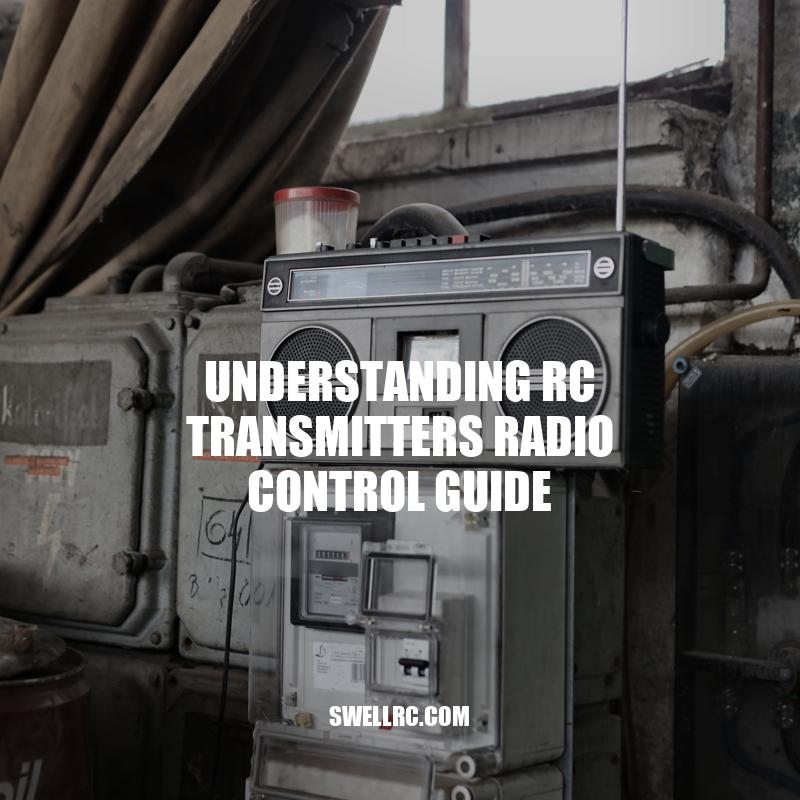Ultimate Guide to RC Transmitters: Understanding Radio Control
Remote control vehicles such as drones, cars, and airplanes have become increasingly popular over the years, and with good reason. They offer a fascinating way to experience the thrill of controlling a tiny machine and can be enjoyed by people of all ages. One of the most important parts of a remote control vehicle is the transmitter, which serves as the link between the operator and the vehicle. The transmitter sends radio signals that are received by the vehicle, allowing the operator to control its movements from a distance. Understanding how to use an RC transmitter is crucial for smooth and effective operation of an RC vehicle. It’s also essential for ensuring safe use, as a poorly operated vehicle could cause harm to the operator, bystanders, or property. In this guide, we’ll dive into everything you need to know about understanding RC transmitters. From the components of a transmitter to setting it up and using it effectively, we’ll cover all the bases so that you can confidently take control of your RC vehicle.
Components of RC Transmitters
RC transmitters have several parts that enable the operator to control the vehicle’s movements. These components include:
- Joystick or wheel: used for steering
- Throttle: controls acceleration and speed
- Switches: for additional features like taking pictures and changing modes
- Antenna: sends and receives signals between the transmitter and the vehicle
- Trim buttons: adjust steering or throttle response
Understanding the functions of each component is essential for effectively using an RC transmitter. If you’re looking to purchase an RC transmitter, there are several options on the market. Websites like Amazon and HobbyKing offer a wide selection of RC transmitters, each with varying features and price ranges. It’s important to do thorough research before purchasing an RC transmitter to find one that meets your needs and fits within your budget.
What are the parts of the transmitter?
The parts of a typical transmitter include:
- Antenna
- Modulator
- Oscillator
- Power supply
- Input device
- Output connector
To learn more about transmitters and how they work, check out resources like science and technology websites, educational books, and online courses. If you’re interested in purchasing a transmitter for personal or professional use, be sure to do your research and choose a reputable brand or supplier.
Setting Up an RC Transmitter
Properly setting up your RC transmitter is essential for ensuring the safety and optimal performance of your vehicle. Here are the steps for setting up your RC transmitter:
Step 1: Select the frequency and channel
- Choose an unoccupied frequency and channel to avoid signal interference from other RC vehicles or devices.
- Frequencies are measured in MHz (megahertz), and channels range from 1 to 8.
Step 2: Set up the transmitter
- Power on the transmitter with batteries or a power source.
- Adjust the settings for the type of RC vehicle you’ll be operating.
- Pair the transmitter with the vehicle’s receiver by connecting them using the appropriate cables.
Step 3: Adjust the settings
- Fine-tune the transmitter’s settings and adjust the trim buttons to optimize the vehicle’s performance.
- Ensure that the RC vehicle responds to the transmitter’s movements correctly.
It’s important to always follow the manufacturer’s instructions when setting up your RC transmitter. There are several websites and guides available online that provide more detailed information on how to set up an RC transmitter, such as RCGroups and RC Driver. In addition, some RC transmitters come with instructional manuals and videos to help you through the process.
The Importance of Battery Life
It’s crucial to monitor your transmitter’s battery life to avoid losing control of your RC vehicle in the middle of operation. Consider investing in rechargeable batteries to ensure longer and more reliable use. Below is a comparison table of some popular rechargeable battery brands:
| Brand | Price Range | Battery Life |
|---|---|---|
| Eneloop Pro | $20-$30 | Up to 2550mAh |
| Duracell Rechargeable | $10-$20 | Up to 2400mAh |
| Energizer Rechargeable | $10-$20 | Up to 2300mAh |
Remember, maintaining your RC transmitter’s battery life is essential for a seamless and enjoyable experience.
How do you bind an RC transmitter?
To bind an RC transmitter, follow these steps:
- Turn on the transmitter and the receiver.
- Enter the binding mode on the transmitter. This can usually be done by holding down a specific button or combination of buttons.
- Press the binding button on the receiver.
- Wait for the two devices to connect and the binding process to complete.
For specific instructions on how to bind your particular transmitter and receiver, consult the user manual or the manufacturer’s website.
Some popular websites for purchasing RC transmitters and receivers include Horizon Hobby, Tower Hobbies, and Amazon.
Using an RC Transmitter Effectively
Once your RC transmitter is properly set up, it’s time to start using it effectively. Here are some tips to help:
Start Small
- Begin with an RC vehicle that’s easy to control, such as a slow-moving car or a drone with a camera.
Practice, Practice, Practice
- Practice operating the RC vehicle in a safe and open area, such as a large field or a parking lot with few people or obstacles.
- Start by controlling the vehicle’s movements at a low speed and gradually increase it as you become more comfortable.
Stay Safe and Follow Regulations
- Read and follow local laws and regulations regarding RC vehicles.
- Always keep a safe distance from people or animals.
- Avoid flying or operating the RC vehicle in harsh weather conditions or in areas with poor visibility.
Maintenance and Upkeep
- Regularly clean and maintain your RC transmitter and vehicle to ensure optimal performance and longevity.
- Check the battery life and replace or recharge batteries as needed.
- Inspect the transmitter’s components regularly, such as the antennae and the buttons, and replace any worn-out parts.
By following these tips, you’ll be able to effectively use your RC transmitter and vehicle while ensuring your safety and the safety of those around you. If you’re looking for more information on how to use an RC transmitter, make sure to check out online forums and websites specializing in RC vehicles, such as RC Universe and RC Driver. These sites offer a wealth of knowledge and resources for RC enthusiasts of all levels.
How do I match my RC transmitter and receiver?
To match your RC transmitter and receiver, follow these simple steps:
- Check the frequency of your transmitter and receiver to make sure they are compatible.
- Set the transmitter and receiver to the same frequency.
- Bind the transmitter and receiver together according to the manual’s instructions.
- Test the controls to ensure they are all functional before flying your RC plane or drone.
For more detailed instructions, visit websites such as Flite Test or RC Airplane World. You can also check out products like the Spektrum DX6e DSMX 6-Channel Transmitter and receiver set available on Amazon.
Conclusion
In conclusion, learning how to use an RC transmitter is a crucial skill for all RC enthusiasts. By understanding the components of your transmitter, setting it up properly, and following safe and effective practices, you’ll be able to operate your RC vehicles efficiently and enjoyably. Always remember the importance of maintaining and cleaning both the vehicle and transmitter, following local regulations, and staying safe during operation.
Additionally, there are many resources online for RC enthusiasts, such as RC forums, groups, and websites specializing in RC vehicles. These resources provide valuable knowledge, advice, and product recommendations. Do your research before making a purchase and ask for help if you are unsure about anything. With the right equipment, knowledge, and practice, you’ll soon be using your RC transmitter like a pro.



